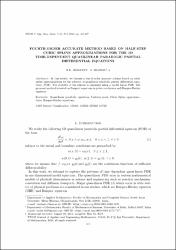Fourth-order accurate method based on half-step cubic spline approximations for the 1d time-dependent quasilinear parabolic partial differential equations
Citation
Fourth-order accurate method based on half-step cubic spline approximations for the 1d time-dependent quasilinear parabolic partial differential equations. TWMS Journal Of Applied And Engineering Mathematics, 10(2), 415-427.Abstract
In this article, we discuss a fourth-order accurate scheme based on cubic spline approximations for the solution of quasilinear parabolic partial differential equations (PDE). The stability of the scheme is discussed using a model linear PDE. The proposed method is tested on Burgers’ equations in polar coordinates and Burgers-Huxley equation.
Volume
10Issue
2URI
http://belgelik.isikun.edu.tr/xmlui/handle/iubelgelik/2829http://jaem.isikun.edu.tr/web/index.php/archive/105-vol10no2/532
Collections
The following license files are associated with this item:
Related items
Showing items related by title, author, creator and subject.
-
On the solutions of some nonlinear fredholm integral equations in topological Hölder spaces
Temizer Ersoy, Merve; Furkan, Hasan; Sarıçiçek, Büşra (Işık University Press, 2020-03-18)In this article, we show that the existence theorem for fredholm type quadratic integral equation in the space of functions satisfying H¨older the condition, based on the classical Schauder fixed point theorem, has new ... -
Hydrodynamic limit of the Boltzmann-Monge-Ampere system
Ben Belgacem, Fethi (Işık University Press, 2019)This paper investigates the hydrodynamic limit of the Boltzmann-MongeAmpere system in the so-called quasineutral regime and more precisely the convergence of the Boltzmann-Monge-Ampere system to the Euler equation by using ... -
Global existence and nonexistence of solutions for a klein-gordon equation with exponential type nonlinear term
Taşkesen, Hatice (Işık University Press, 2020)In this paper, the global existence and nonexistence of solutions for a KleinGordon equation, appearing in a variety of physical situations, with exponential type source term and supercritical initial energy (E(0) > d) are ...





